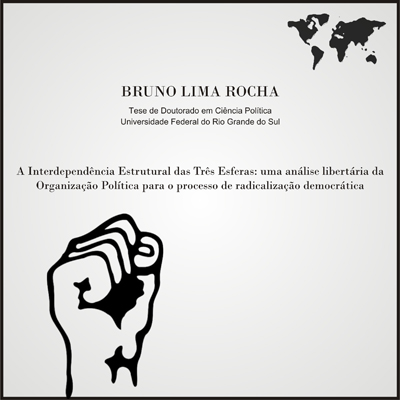

.jpg)
















|
Original Content in English Democratic Confederalism and Collectivist Economics
April 1st 2015 - Bruno Lima Rocha This essay is the beginning of an attempt to develop a left libertarian approach toward an economic model, specifically to a model which is compatible with the political formations of Democratic Confederalism, also referred to as Libertarian Municipalism. At this stage the goal is the development of a working set of tools of analysis, and foster learning among the Libertarian Left. To this end I submit this relatively simple text to provide accessible notions for those struggling to build a society based on Democratic Confederalism. Some ideas have already been defined by others, I will try to explain what is consensus among militants and scholars committed to similar projects. We must accumulate knowledge through real experiences like the ones during the Spanish Revolution(specifically the experiments in Catalonia and Aragón) or during the Russian Revolution (placing primary attention on Ukraine). I recognize that the debate cannot be finished so quickly as the didactic and brief tone of this article, but this first essay part is not meant to close the discussion it relates to, but to open it. A system of economic institutions, be they placed in a revolutionary project or not, must perform specific functions. It must organize production, distribution, consumption, and reinvestment. An economy fit for a self-managed society must pay special attention to justly remunerating (paying) the workers engaged in production. All of these functions require exchange, which begs the question, what will be the medium of exchange. And as such, we must enter the debate that stalks us like a bad hangover from the 20th century – the debate over the role of currency, of money and market mechanisms. And, if a revolutionary project implementing Democratic Confederalism is to allow for the use of money, a second set of questions have to be answered, delineating how far the currency can circulate, and what aspects of the economy will be subjected to “market” mechanisms. Will there be a market for goods and services, limited to primarily personal consumption? Or will we allow money to represent also the productive value in the economy, and allows the means of production to be bought and sold? In other words will we allow money to circulate such that we allow private investment for private profit (capitalism at its most basic scale)? So, the starting point is that money’s role must be limited to exchange of consumer goods. Furthermore, private ownership of either the means of production, or nonproductive speculative assets must not be allowed. Money’s role is to support a locally based system of exchanges and not a tool to produce private wealth. Relying on the work of Abraham Guillem, I propose the beginnings of a model where by money would be used in the local communes (referred to as cantons), but that each of these communes would have their own currency and no market based exchanges would take place between “companies” – in a Business to Business scale – in one canton with another. Rather, the economic exchange between cantons would take place through agreement at the canton level, or through fairs for the exchange of goods (goods for goods, as opposed to goods for currency). Furthermore the productive assets would be controlled locally and socially at the canton level. Through these institutional relations a market for consumer goods and services would fostered within the canton, but democratic federated social control would prevail at the production level and at the level of exchange between cantons. Furthermore, as specific cantons saw fit, they could intervene in regulating the “pricing” inside their canton “level market”. I recognize that key-concepts must be translated to new words, but to avoid representing a false consensus to these “new words”, we will still using the terms already recognized in hegemonic economics. What we are attempting here is to fashion a new collectivism for a new time and new setting. We start with the analysis of some premises that may provide direction and parameters to the discussion. As implied earlier this model is explicitly based on and attempting to elaborate the confluences of two coincident theories: social anarchism (not individual anarchism as a philosophical way of thought) and Democratic Confederalism as the leading new (or renewed) theory to produce a different society. In this text I analyze points from the ground and the bottom-up, by placing attention to local institutions. In the first premise we affirm that Democratic Confederalism is based people operating on local and human scales. For example, let us assume that the minimum scale of society, in which we can find a form of distribution, is a commune of 10 families. Then, we must imagine production at this level, as well as distribution at this level. This basic commune will produce will either share in the spoils of this production through direct planning or will pay workers engaged in this production with a local currency or consumption credit system. Production at this commune level which is not consumed at the commune level may be traded in exchanging fairs organized by federations to mediate work between communes. Similar fairs for exchange occurred in Ferias de Trueque that occurred in Argentina and Uruguay during the worst neoliberal crisis years. In this sense I assume that there is a role for the individual, individuality, and creative work. We can combat “black markets” by institutionalizing open fairs, but never allowing that essential goods are uniquely distributed in the local fairs, but through Canton scale institutionalized distribution. In the second premise, this same local entity must assure, through a system of self-management, organized by these people, that all essential institutions are sustained by collective work. So, currency – local canton money – exists only as a market for consumer goods and services, and not as private investment capital or private ownership of the means of production. In the third premise, as we can verify, this theory allows individuals and small groups to produce goods to be exchanged for other goods on a small scale. And, this theory also assures that the essential institutions are not estimated in a monetary calculus, being sustained by the collective. The concept of essential institutions is something decided and classified by the people’s power, people’s assembly, in a participatory way of making decisions. In the fourth premise, we assure that the “money” is the accountable unit for exchanging goods (not all goods, but some of them) inside a canton, and not wider than that. So, “local canton money” is not portable, like financial capital or printed dollars, euros or pounds. It would not be used for banking transactions. For example: if a citizen goes from one canton to another, he would receive an amount of other local canton money for his private use, being assured that essential needs are provided by collective work and social institutions. In the fifth premise, local canton money must have an equivalence to other “local canton money” but cannot circulate outside of the federal unit where its value was produced and accounted. In the sixth premise we assume that time dedicated to social institutions must be “paid” – remunerated. However, we must not allow large disparities in remuneration between types of labor, so that a full-fledged market in labor does not reappear. It is not a good rationality in socialist terms to think about a difference in wage, but if we consider the role of individual liberty, there could exist some (or a decent amount of) individuals that would not consider full adherence to collectivization. In the seventh premise we assume that time and dedication are two of the basic theory tools for feminist critiques of political economy, and of course, the basics of feminist economics, considering essential the question of “invisible work”, and not compensated working force in capitalism and patriarchate, for example house keepers, maids and wives. This – in the majority – female work-force produces richness but stays “invisible” in capitalism. One of the problems is, that they do not get paid, not even a small recognition in the unjust wage system. So, as the project must go on the other way of capitalism, this “invisible” work must be substituted by collective work and become visible thus compensated. This may require pooling of resources between cantons to assure a minimum level of remuneration of domestic labor. In the eighth premise, the last in this short essay, we assume that time and dedication must be compensated by “local canton currency”. The wage must be defined by institutions based on peoples’ power, coordinated among all cantons and could not reproduce an unjust way of compensating the work force as a mirror for a pyramidal society. As long as the project belongs to a horizontal society, compensation must reproduce the society model, not allowing leaders to live in better material conditions than citizens. To do so, leaders must be renewed and not become a new ruling class. We will continue the essay in further occasions, growing the complexity of models, trying to finish it in a proposition that would allow the liberated territories to interchange strategic goods even with constituted states, but never allowing these states and private or transnational capital to exploit the territory or the people living there. The first and original version was published in Conjuncture Magazine and the articles about Democratic Confederalism and Anarchism is part of an effort to get otgether these two political traditions and praxis. |

.jpg)